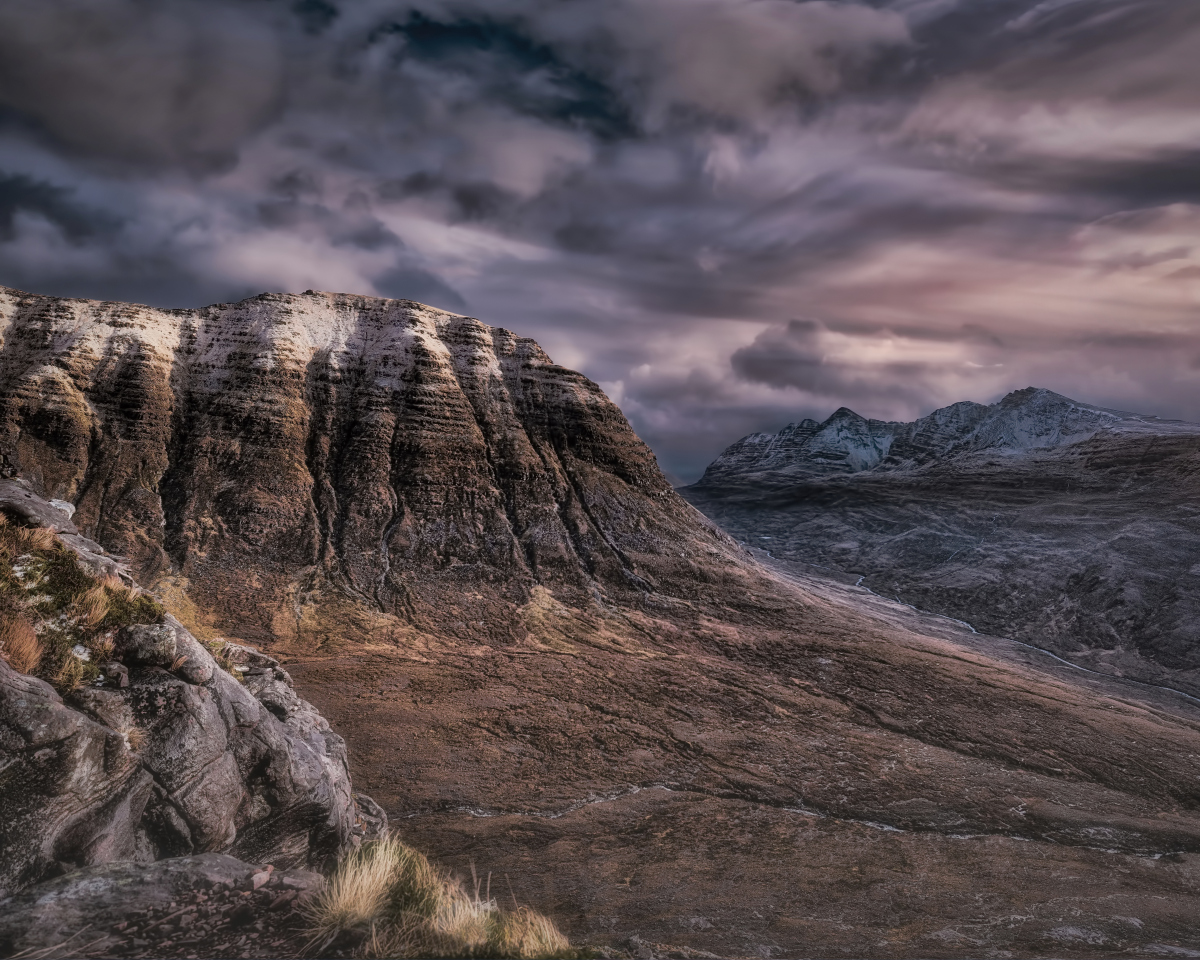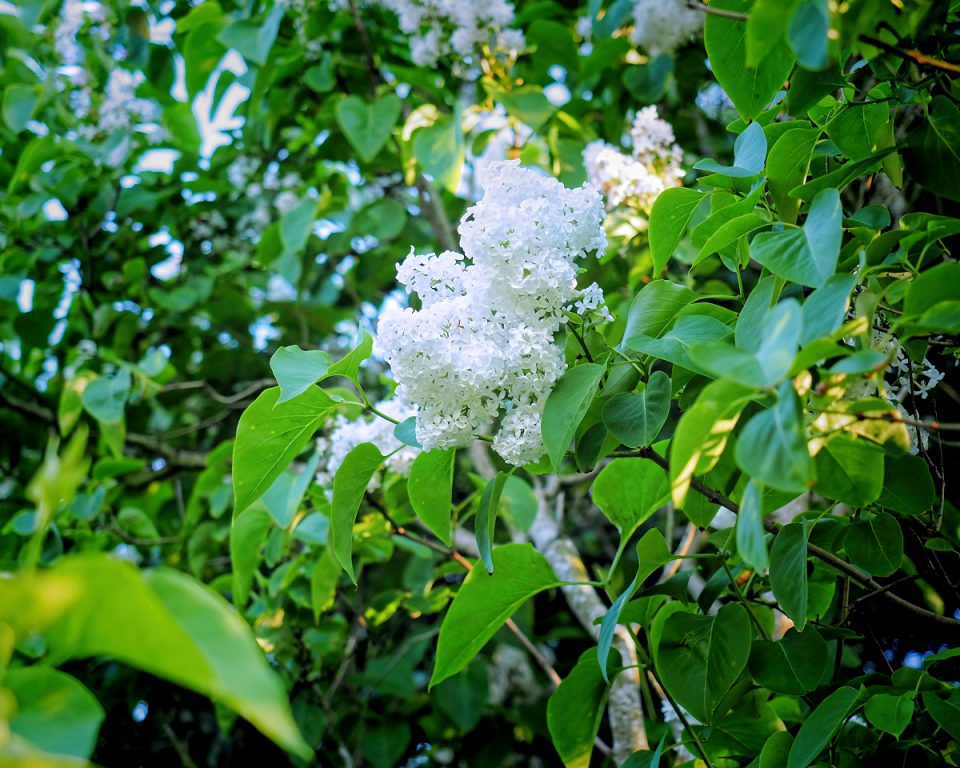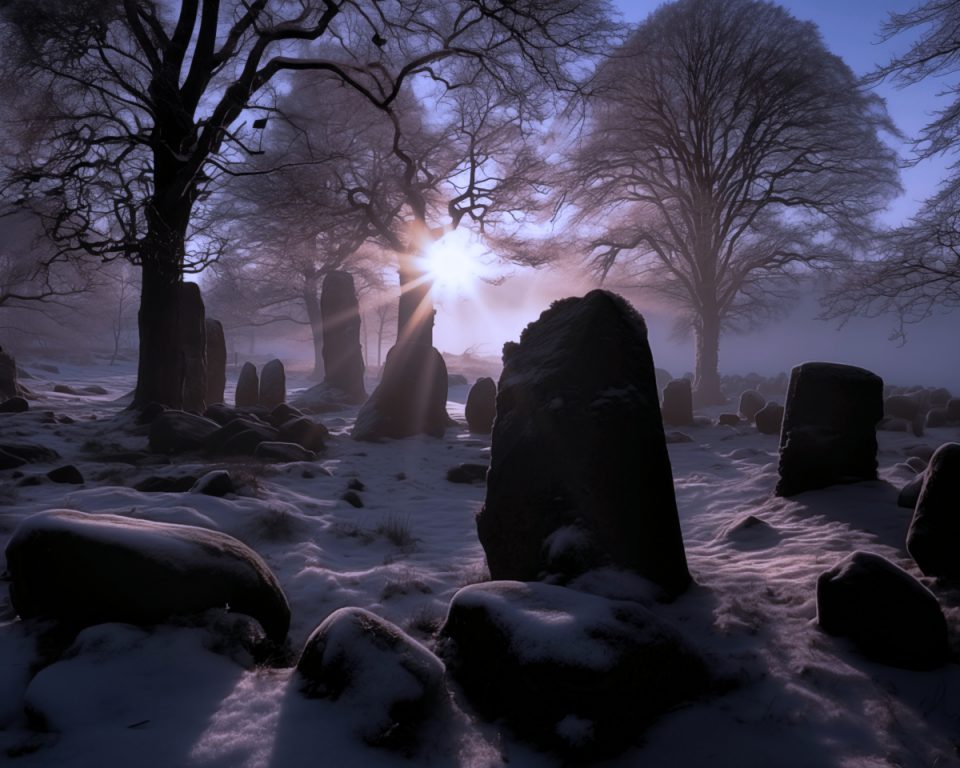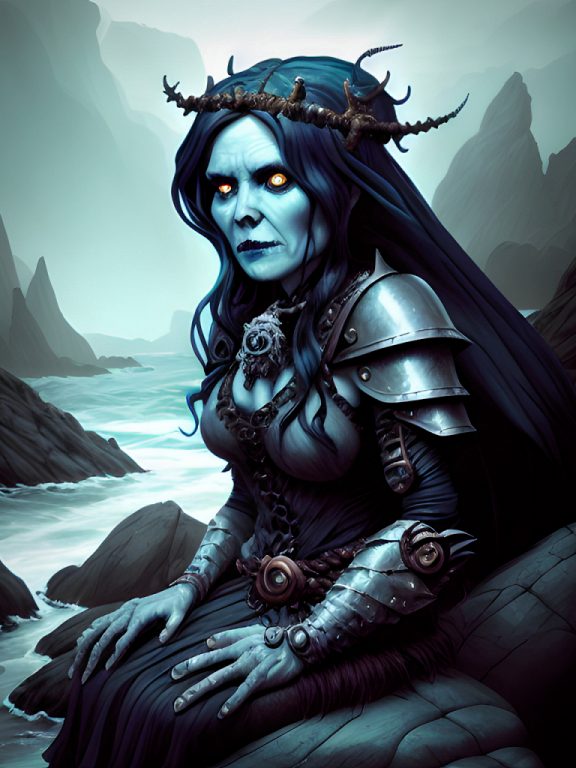Torridon is a wild and enchanting corner of the Western Highlands of Scotland. It is a land of water and ancient mountains, some of which are over two billion years old. It seems that the mountains dip their feet in the sea lochs and hold their heads high in the clouds. Although it is a harsh and unforgiving land, there is evidence that people have lived here from Bronze Age times. The origins of the place names show a succession of peoples: Picts, Vikings and Gaels.
For centuries this was an area steeped in the culture of the Gàidhealtachd. This was the heartland of Clan McKenzie, who would fight on behalf of Bonnie Prince Charlie during the Jacobite Rebellion. These were people who eked a meagre living from the land, who found themselves displaced by sheep during the Highland Clearances by a man named Colonel MacBarnet. Like all who live close to the land, their beliefs were strongly steeped in the elemental forces: ghosts, demons, spirits and the second sight. It seems it was more than just eagles and deer that lived amongst the creatures said to inhabit the rocky peaks of Torridon.
The Great Yellow Goat
Once there lived a man in Braebeg, between Alligin and Wester Alligin. In order to get Communion in Gairloch, he would walk over an area between Diabeg and Gairloch known as Druim Buie. However, this was a dangerous task as a huge yellow goat would attack people travelling on this route and had even killed some of the travellers.
One day the man stopped en route when he came to a house on the Druim Buie. This belonged to a tailor and his wife, and they took him in and gave him food and drink as was the custom.
“Are you not afraid of meeting the goat?” the tailor asked.
The man shook his head for he was a keen hunter; he had his trusty gun and his sword and had dispatched many a beast.
Refreshed, he set off on his journey once more, but he had scarcely travelled any distance when he came face to face with the goat. Sure enough, it attacked him, knocking him down and trampling him with its cloven hooves. He struck it twice with his sword but to no avail. The sword bent. He fired his gun, but the bullets did no harm. Desperation set in as he grappled with the goat for it seemed that he was about to end his days under the goat’s feet. Then he remembered that he was carrying a small dirk in his stocking. He struck two blows and the goat ran off, roaring in agony.
The Beast Exposed
Pouring with blood, the man staggered back to the tailor’s house and pounded on the door. The door edged open, and the tailor’s wife peeped round. She tried to shoo the man away, but the man was in desperate need and barged into the house. To his horror, he discovered the tailor lying on the floor with two mortal stab wounds. Realising the true nature of the tailor he quickly dispatched him.
The tailor it seemed had been using witchcraft to turn himself into a goat. By questioning the guests who called in at his cottage, he was able to ascertain what weapons they carried. Then he used supernatural means to resist them. Thus, he was prepared in advance for the hunter’s gun and sword and was able to protect himself against them. But he had no knowledge of the dirk which gave him his fatal wounds. From that day onwards the Great Yellow Goat has never terrorised the people on the Drium Buie.
However, if you are travelling in the West Highlands, you might be lucky to see feral goats roaming the moorland.
The Ghosts of Torridon
Perhaps Torridon’s most famous ghost is Bodach Stàbhais or ‘Stabhais’ Ghost’. Murdo McKenzie was a postman at Diabeg and apparently, he was nick-named Stàbhais (‘bandy-legged’). One night he was returning home to Diabeg with the mail when suddenly he was surrounded by fire at a place called Glac a’ Bhodaich. Rooted to the spot, a headless apparition appeared before him and told him that he had been brutally murdered and was buried on top of the hill. His name was also Murdo, and he would appear only three more times but on each occasion to someone called Murdo.
The ghost disappeared and Murdo returned home, shaken. He told his neighbours about his encounter but alas they laughed at him. Murdo was not going to be mocked. He insisted that they come with him and dig at the spot where the ghost had indicated. Imagine their horror as they unearthed the bones of a murder victim!
If your name is Murdo and you plan to visit Torridon, you might want to avoid the area of Glac a’ Bhodaich near Diabeg!
The Ghost at Craig
The road to Diabaig climbs and winds tortuously beneath Beinn Alligin. You would be forgiven for thinking that you had reached the edge of civilisation. However, once another community eked out its existence a few miles beyond this. The tiny settlement nestled in the valley and bay where the Craig River tumbles into the sea, and could only be reached by a path, or by water. This was Craig, a handful of old crofts that sat up behind the rocky beach. Life was tough there: remote in the extreme, with whistling winds blasting off the sea. The village was abandoned in the 1930s.
However, when the village was still in use a tinker woman, heavy with child was making her way to Craig on the rough path to Diabeg. The winter snows had fallen and the bitter cold and wind gnawed at the woman as her contractions began. She was almost there. So close! Within sight of the houses, she gave birth to her child but the cold and the falling snow proved too much for them. Their bodies were found the next day.
Her ghost was frequently seen, sometimes in broad daylight, slowly descending the steep path to the houses. Then at the foot of the hill, in a natural hollow, the apparition would mysteriously disappear.
Witches in Torridon
The Scottish Witch Trials were more a phenomenon of Lowland Scotland. Belief in witches and fairies was more accepted in the Highlands and those suspected of dabbling in magic were not persecuted as severely as those in the rest of the country. With a few exceptions such as the Brahan Seer and Janet Horne, most ‘witches’ were left alone.
Despite their more liberal acceptance of witchcraft, the Highlanders were still afraid of the Evil Eye or buisneachd as it is known in Gaelic. However, not all witches abused their powers. The tale is told of one John Maclennan of Corry in Torridon. He was a fisherman and lived in the little crofters’ houses with his sister His sister was up in the hills with the cows while he was at home making dinner. It was common fayre- potatoes and herring.
The ‘tatties’ were boiling when three strange cats came to the door, two black ones and a reddish-brown one with only one eye. They looked wet, cold, and miserable. John was a kindly man, and he took pity on the cats and let them sit by the fire. Then he threw them some herring and before long, the cats had eaten more herring than he had.
Once they were heated and fed, the cats got up and moved towards the door. The cats left and John thought no more about it until a year or two later.
The Lewis Witches
John was at the herring fishing at Loch Roag on the Island of Lewis. He and a crewman set out to look for lodgings, but the place was heavy with fishermen who had been following the herring. He did not hold much hope of securing a place to bed down for the night. Nonetheless, on the first door he knocked on, a fine-looking woman beckoned him in and told him to make himself at home. John was surprised at the warm welcome from the stranger, but he went ahead and asked for a night’s lodgings.
The woman replied, “Well this house is full but since you are the kindest man that I have ever met, it would be ill of me if you could not get a night’s lodging here.”
“When did I ever meet you?” John asked, racking his brains.
“Do you remember when you fed three cats by your fire at Torridon? Well, that was us.”
At that point two other women entered the room, one was red-headed and had only one eye.
It transpired that the three women were witches who had gone to Torridon in the form of whales, to chase fish into the nets of some fishermen from Lewis. Needing a rest, they had come ashore, transformed into cats and came to the nearest house.
John spent the night at the woman’s house, but sleep eluded him. That was the last night he slept in Lewis, far less Loch Roag.
The Healing Well at Torridon
In the past, wells and springs played an important role in the lives of the people of Scotland. In the Old Religion they were associated with Goddesses and today many are still associated with Brìde or the Nine Maidens.
Often wells were associated with healing. One such well from the Torridon area. In a book called ‘Old Scottish Customs’ it says:
“In a churchyard on Loch Torridon there is a well where, it used to be said, from time immemorial three stones have been perpetually whirling round and round. All kinds of sickness and disease have been cured by carrying one of these stones in a bucket of water to the invalid, who was required to touch the stone to be restored to health. Its mission accomplished, the Talisman was restored to its place, when it commenced as before! But alas! One of these healing stones now lies quietly at the bottom of the well, refusing any longer to whirl like the others, simply because a woman, great in her faith, once took it home with her to perform a cure on her sick goat.”
It seems, however, that neither of the two churchyards in Torridon have wells but the authors of the book may have gotten mixed up in their details of local lore. There is another tale in which the stones swirled in a pool in a stream called Allt nan Corp. In this version, the stones stopped working because the gravediggers from the nearby cemetery washed their tools in the pool. The stones disappeared forever.
Allt nan Corp and the Effigies
The stream Allt nan Corp is interesting for another reason. In the olden days, it was a common practice for people to make a clay effigy and stick pins into it to lay a curse on someone they had a grudge against. In Gaelic, this effigy was called the ‘Corp Crèadha’ or ‘Clay Body’. The stream takes its name from the effigies and a story about one particular incident.
One of the Mackenzie Lairds of Torridon brought in a Lowlander to watch his salmon in the River Torridon. It seems he did his job rather too well and upset the villagers in Annat who were prone to supplement their diet with a little poached salmon! At the end of the season, the man was making his way home but did not get very far. Unfortunately, he was caught by the tide while crossing the estuary. Then the laird himself was struck by a mysterious ailment. The doctors were at a loss to diagnose the illness.
Soon a local man, reputed to have healing powers was enlisted to save the Laird’s life. He declared that the cause of the illness was one of these clay effigies. Another man was recruited. He was called Tormod Mór Mac Iain Lèith from Kinlochewe. Tormod was gifted with the ‘cnaimh luirg’ (literally the bone tracker) or the art of finding things by divination. By using his art, he discovered the effigy in Allt nan Corp where it was dissolving in the water. It was immediately removed and the family behind the curse promptly left Annat and moved to Applecross.
Christianity Merging with the Old Religion at Torridon
When Christianity first arrived in Scotland, a policy was followed where the ancient holy sites and feasts were assimilated into Christianity and dedicated to a Christian saint. Thus wells formerly dedicated to Brìde became dedicated to Saint Brigit and Christmas replaced Yule.
The West Coast north of the former Kingdom of Dal Rìata would have been Pictish at the time Christianity arrived in the area. In AD 673 St. Maelrubha or the ‘Red Priest’ arrived from Northern Ireland and established a monastery and surrounding Sanctuary at Applecross. This was to be second only to Iona in terms of religious importance. He died in Applecross in AD 722 and is buried in the graveyard. Unfortunately, Vikings destroyed the church during a raid in AD 795.
Maelrubha and Bull Sacrifice
Maelrubha is also said to have built a small chapel on Isle Maree, one of the islands of Loch Maree. The Loch thereafter was named after the Saint. It seems that the early peoples mixed their old beliefs with those of Christianity for hundreds of years. The advent of the Protestant Reformation brought with it, a major crackdown on the old superstitions mingled with ancient beliefs. Thus on the 5th September 1656, the Achnashellach men were summoned to appear before the Presbytery in Applecross charged with sacrificing bulls on the 25th August to Saint Mourie (Saint Maelrubha).
The Sacrificing of Bulls was also still being practised at this time in Loch Maree. Could this have been the vestiges of an old Pictish practice? After all, the Rhynie Man Stone discovered at what seems to be an important Pictish elite site, bears a carving of a greatly caricatured man bearing the kind of ceremonial axe which was used to sacrifice bulls. There may be evidence of a bull cult at Burghead where a series of bull carvings were found.
A Word of Caution
A word of caution when visiting Scotland’s west coast: when the mists descend, as they inevitably will do, there may be worse things lurking in the haze than hordes of blood-sucking midges!




